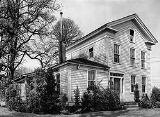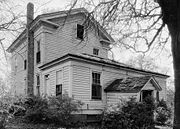
Alvin T. Smith House
Encyclopedia
The Alvin T. Smith House is a two-story home on Elm Street in Forest Grove, Oregon
, United States
. Completed in 1856, it is the second oldest building in the city and was added to the National Register of Historic Places
in 1974. A Greek Revival style house, it was built by pioneer Alvin T. Smith
beginning in 1854.
south of what became West Tuality Plains in 1841. He and his wife were the first permanent Euro-American settler at that community that would later become Forest Grove. An earlier cabin on the property was destroyed in a flood, and their second cabin later became a post office
. In 1854, he and his wife Abigail began the construction of a new home. Alvin was a trained carpenter
and did the work himself. Construction finished in 1856, and is the second oldest wood framed building in Forest Grove after Old College Hall at Pacific University
. Abigail died in 1858, with Alvin continuing to live in the home with his second wife Jane until 1870. The couple moved to downtown Forest Grove, but continued to own the property.
Alvin died in 1888, and Jane leased the house until around 1920 when she died. The next owner sold the estate to the Zurcher family circa 1940. Alvin T. Smith House was listed on the National Register of Historic Places
on November 8, 1974. The house was abandoned around 1990.
In 2002, the Friends of Historic Forest Grove began plans to purchase the home and restore it. The group worked with the Oregon Historic Preservation Office to purchase the property. In 2005, a methamphetamine
lab was removed from the basement and the house decontaminated. In March 2005, the group purchased the home for $75,000 after raising $175,000, with some of the funds raised through a calendar featuring nude members at the house. Long term plans call for turning the property into a center for learning about the cultural heritage of the area.
 The home sits on a 2.2 acre (0.8903092 ha) site on the south side of Forest Grove
The home sits on a 2.2 acre (0.8903092 ha) site on the south side of Forest Grove
off Oregon Route 47. Smith House is of a classical Greek Revival design with a side hall floor plan
. The gabled side serves as the front of the structure. The two story building includes a basement. The basement consists of stone walls with brick on the top as the foundation. The basement remained cool and was utilized as storage for perishables such as fruit and vegetables.
Above ground, rough-hewn
logs were used, as were wooden pegs to hold the timbers in place. Smith hewned the timber by hand using a broad ax. On the main floor there are multiple doors between the same room to allow for church meetings. There were no church buildings in the early days of the community, so religious services were held in private homes. The home has wood floors, with two bedrooms on the second floor. All the windows are partitioned window
s. Most of the original structure remains.
and moved to the Oregon Country
in 1840. The next year he moved to the Tualatin Plains
near what became Forest Grove. There he represented the area at the Champoeg Meetings
in 1843 and helped support Tualatin Academy
and to found Pacific University
. Smith was postmaster from 1851 to 1855.
Forest Grove, Oregon
Forest Grove is a city in Washington County, Oregon, United States, west of Portland. Originally a small farm town, it is now primarily a bedroom suburb of Portland. Settled in the 1840s, the town was platted in 1850 and then incorporated in 1872 and was the first city in Washington County...
, United States
United States
The United States of America is a federal constitutional republic comprising fifty states and a federal district...
. Completed in 1856, it is the second oldest building in the city and was added to the National Register of Historic Places
National Register of Historic Places
The National Register of Historic Places is the United States government's official list of districts, sites, buildings, structures, and objects deemed worthy of preservation...
in 1974. A Greek Revival style house, it was built by pioneer Alvin T. Smith
Alvin T. Smith
Alvin Thompson Smith was an American missionary and politician in what became the state of Oregon. A native of Connecticut, he lived in Illinois before moving to the Oregon Country to preach to the Native Americans in the Tualatin Valley...
beginning in 1854.
History
Alvin Smith settled on a 643 acres (260 ha) farm on the Tualatin PlainsTualatin Plains
The Tualatin Plains are a prairie area in central Washington County, Oregon, United States. Located around the Hillsboro and Forest Grove areas, the plains were first inhabited by the Atfalati band of the Kalapuya group of Native Americans. Euro-American settlement began in the...
south of what became West Tuality Plains in 1841. He and his wife were the first permanent Euro-American settler at that community that would later become Forest Grove. An earlier cabin on the property was destroyed in a flood, and their second cabin later became a post office
Post office
A post office is a facility forming part of a postal system for the posting, receipt, sorting, handling, transmission or delivery of mail.Post offices offer mail-related services such as post office boxes, postage and packaging supplies...
. In 1854, he and his wife Abigail began the construction of a new home. Alvin was a trained carpenter
Carpenter
A carpenter is a skilled craftsperson who works with timber to construct, install and maintain buildings, furniture, and other objects. The work, known as carpentry, may involve manual labor and work outdoors....
and did the work himself. Construction finished in 1856, and is the second oldest wood framed building in Forest Grove after Old College Hall at Pacific University
Pacific University
Pacific University is a private university located in Oregon, United States. The first campus began more than 160 years ago and is located about 38 km west of Portland in Forest Grove...
. Abigail died in 1858, with Alvin continuing to live in the home with his second wife Jane until 1870. The couple moved to downtown Forest Grove, but continued to own the property.
Alvin died in 1888, and Jane leased the house until around 1920 when she died. The next owner sold the estate to the Zurcher family circa 1940. Alvin T. Smith House was listed on the National Register of Historic Places
National Register of Historic Places
The National Register of Historic Places is the United States government's official list of districts, sites, buildings, structures, and objects deemed worthy of preservation...
on November 8, 1974. The house was abandoned around 1990.
In 2002, the Friends of Historic Forest Grove began plans to purchase the home and restore it. The group worked with the Oregon Historic Preservation Office to purchase the property. In 2005, a methamphetamine
Methamphetamine
Methamphetamine is a psychostimulant of the phenethylamine and amphetamine class of psychoactive drugs...
lab was removed from the basement and the house decontaminated. In March 2005, the group purchased the home for $75,000 after raising $175,000, with some of the funds raised through a calendar featuring nude members at the house. Long term plans call for turning the property into a center for learning about the cultural heritage of the area.
Details

Forest Grove, Oregon
Forest Grove is a city in Washington County, Oregon, United States, west of Portland. Originally a small farm town, it is now primarily a bedroom suburb of Portland. Settled in the 1840s, the town was platted in 1850 and then incorporated in 1872 and was the first city in Washington County...
off Oregon Route 47. Smith House is of a classical Greek Revival design with a side hall floor plan
Floor plan
In architecture and building engineering, a floor plan, or floorplan, is a diagram, usually to scale, showing a view from above of the relationships between rooms, spaces and other physical features at one level of a structure....
. The gabled side serves as the front of the structure. The two story building includes a basement. The basement consists of stone walls with brick on the top as the foundation. The basement remained cool and was utilized as storage for perishables such as fruit and vegetables.
Above ground, rough-hewn
Timber framing
Timber framing , or half-timbering, also called in North America "post-and-beam" construction, is the method of creating structures using heavy squared off and carefully fitted and joined timbers with joints secured by large wooden pegs . It is commonplace in large barns...
logs were used, as were wooden pegs to hold the timbers in place. Smith hewned the timber by hand using a broad ax. On the main floor there are multiple doors between the same room to allow for church meetings. There were no church buildings in the early days of the community, so religious services were held in private homes. The home has wood floors, with two bedrooms on the second floor. All the windows are partitioned window
Window
A window is a transparent or translucent opening in a wall or door that allows the passage of light and, if not closed or sealed, air and sound. Windows are usually glazed or covered in some other transparent or translucent material like float glass. Windows are held in place by frames, which...
s. Most of the original structure remains.
Namesake
Alvin Thompson Smith (1802–1888) was born in ConnecticutConnecticut
Connecticut is a state in the New England region of the northeastern United States. It is bordered by Rhode Island to the east, Massachusetts to the north, and the state of New York to the west and the south .Connecticut is named for the Connecticut River, the major U.S. river that approximately...
and moved to the Oregon Country
Oregon Country
The Oregon Country was a predominantly American term referring to a disputed ownership region of the Pacific Northwest of North America. The region was occupied by British and French Canadian fur traders from before 1810, and American settlers from the mid-1830s, with its coastal areas north from...
in 1840. The next year he moved to the Tualatin Plains
Tualatin Plains
The Tualatin Plains are a prairie area in central Washington County, Oregon, United States. Located around the Hillsboro and Forest Grove areas, the plains were first inhabited by the Atfalati band of the Kalapuya group of Native Americans. Euro-American settlement began in the...
near what became Forest Grove. There he represented the area at the Champoeg Meetings
Champoeg Meetings
The Champoeg Meetings in Oregon Country were the first attempts at governing in the Pacific Northwest by United States European-American pioneers. Prior to this, the closest entity to a government was the Hudson's Bay Company, mainly through Dr...
in 1843 and helped support Tualatin Academy
Tualatin Academy
Tualatin Academy was a secondary school in the U.S. state of Oregon that eventually became Pacific University. Tualatin Academy also refers to the National Register of Historic Places-listed college building constructed in 1850 to house the academy, also known as Old College Hall...
and to found Pacific University
Pacific University
Pacific University is a private university located in Oregon, United States. The first campus began more than 160 years ago and is located about 38 km west of Portland in Forest Grove...
. Smith was postmaster from 1851 to 1855.

